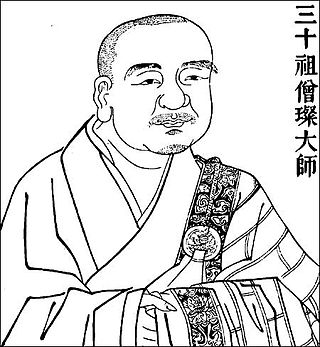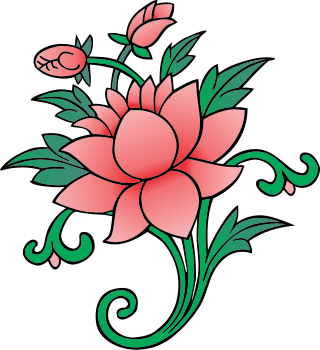
Bodhidharma was a semi-legendary Buddhist monk who lived during the 5th or 6th century CE. He is traditionally credited as the transmitter of Chan Buddhism to China, and is regarded as its first Chinese patriarch. According to a 17th-century apocryphal story found in a manual called Yijin Jing, he began the physical training of the monks of Shaolin Monastery that led to the creation of Shaolin kungfu. He is known as Dámó in China and as Daruma in Japan. His name means "dharma of awakening (bodhi)" in Sanskrit.

The Laṅkāvatāra Sūtra is a prominent Mahayana Buddhist sūtra. It is also titled Laṅkāvatāraratnasūtram and Saddharmalaṅkāvatārasūtra. A subtitle to the sutra found in some sources is "the heart of the words of all the Buddhas".

A dōjō is a hall or place for immersive learning, experiential learning, or meditation. This is traditionally in the field of martial arts, but has been seen increasingly in other fields, such as meditation and software development. The term literally means "place of the Way" in Japanese.

Gōjū-ryū (剛柔流), Japanese for "hard-soft style", is one of the main traditional Okinawa styles of karate, featuring a combination of hard and soft techniques. Both principles, hard and soft, come from the famous martial arts book used by Okinawan masters during the 19th and 20th centuries, the Bubishi. Gō, which means hard, refers to closed hand techniques or straight linear attacks; jū, which means soft, refers to open hand techniques and circular movements. Gōjū-ryū incorporates both circular and linear movements into its curriculum, combining hard striking attacks such as kicks and close hand punches with softer open hand circular techniques for attacking, blocking, and controlling the opponent, including joint locks, grappling, takedowns, and throws.

A japamala, jaap maala, or simply mala is a loop of prayer beads commonly used in Indian religions such as Hinduism, Buddhism, Jainism and Sikhism. It is used for counting recitations (japa) of mantras, prayers or other sacred phrases. It is also worn to ward off evil, to count repetitions within some other form of sadhana such as prostrations before a holy icon. They are also used as symbols of religious identification.
Manas-vijnana is the seventh of the eight consciousnesses as taught in Yogacara and Zen Buddhism, the higher consciousness or intuitive consciousness that on the one hand localizes experience through thinking and on the other hand universalizes experience through intuitive perception of the universal mind of alayavijnana. Manas-vijnana, also known as klista-manas-vijnana or simply manas, is not to be confused with manovijnana which is the sixth consciousness.

Daisetsu Teitaro Suzuki, self-rendered in 1894 as "Daisetz", was a Japanese essayist, philosopher, religious scholar, translator, and writer. He was a scholar and author of books and essays on Buddhism, Zen and Shin that were instrumental in spreading interest in both Zen and Shin to the West. Suzuki was also a prolific translator of Chinese, Korean, Japanese, Vietnamese and Sanskrit literature. Suzuki spent several lengthy stretches teaching or lecturing at Western universities, and devoted many years to a professorship at Ōtani University, a Japanese Buddhist school.

Awakening of Faith in the Mahāyāna is an influential Mahayana Buddhist treatise for East Asian Buddhism.

Jianzhi Sengcan is known as the Third Chinese Patriarch of Chán after Bodhidharma and thirtieth Patriarch after Siddhārtha Gautama Buddha.

Chōjun Miyagi was an Okinawan martial artist who founded the Gōjū-ryū school of karate by blending Okinawan and Chinese influences.

Robert A. Trias was an American karate pioneer, founding the first karate school in the mainland United States and becoming one of the first known American black belts. He also developed Shuri-ryū karate, an eclectic style with roots in Chinese kung-fu, and indirectly some Okinawan karate.
Mushin in Japanese and Wuxin in Chinese is a mental state. Zen and Daoist meditators attempt to reach this state, as well as artists and trained martial artists. They also practice this mental state during everyday activities.
The karate kataSeisan (十三) literally means '13'. Some people refer to the kata as '13 Hands', '13 Fists', '13 Techniques', '13 Steps' or even '13 killing positions'; however, these names have no historical basis.

Kata is a Japanese word describing detailed patterns of movements practiced either solo or in pairs. Karate kata are executed as a specified series of a variety of moves, with stepping and turning, while attempting to maintain perfect form. The kata is not intended as a literal depiction of a mock fight, but as a display of transition and flow from one posture and movement to another, teaching the student proper form and position, and encouraging them to visualise different scenarios for the use of each motion and technique. Karateka "read" a kata in order to explain the imagined events, a practice known as bunkai. There are various kata, each with many minor variations.
The Satipaṭṭhāna Sutta, and the subsequently created Mahāsatipaṭṭhāna Sutta, are two of the most celebrated and widely studied discourses in the Pāli Canon of Theravada Buddhism, acting as the foundation for contemporary vipassana meditation practice. The Pāli texts of the Satipaṭṭhāna Sutta and the Mahāsatipaṭṭhāna Sutta are largely similar in content; the main difference being a section about the Four Noble Truths in the Observation of Phenomena (Dhammānupassana), which is greatly expanded in the Mahāsatipaṭṭhāna Sutta. These suttas (discourses) stress the practice of sati (mindfulness) "for the purification of beings, for the overcoming of sorrow and lamentation, for the extinguishing of suffering and grief, for walking on the path of truth, for the realization of nibbāna."
The table contains a comparison of karate styles. Some of the distinguishing features are listed, such as lineage, general form of stances, the balance of hard and soft techniques, and the number and names of kata forms.

Jitsumi Gōgen Yamaguchi, also known as Gōgen Yamaguchi, was a Japanese martial artist and student of Gōjū-ryū Karate under Chōjun Miyagi. He was one of the most well-known karate-dō masters from Japan and he founded the International Karate-dō Gōjū Kai Association.

Zen is a school of Mahayana Buddhism that originated in China during the Tang dynasty as the Chan School or the Buddha-mind school, and later developed into various sub-schools and branches. From China, Chán spread south to Vietnam and became Vietnamese Thiền, northeast to Korea to become Seon Buddhism, and east to Japan, becoming Japanese Zen.
Peter George Urban was an American martial artist. Called "The George Washington of American Karate" by Kick Illustrated magazine, and "The Godfather of American Goju" by Official Karate magazine. Urban was the founder of the karate style known as American GōJū Ryū Karate Do. He was one of only a small number of white students under Gōgen Yamaguchi, an early Japanese GōJū Ryū Sensei, Practitioner, and Instructor as well as the head of the style's organization, The GoJu Kai. Controversially, Urban created an American style of Gōjū-ryū without the permission of Yamaguchi who would not allow Urban to represent Japanese Karate in America as head representative for the GoJu Kai.
Anutpāda is a Buddhist concept for the absence of an origin. In Mahayana Buddhism, "anutpāda" is often symbolized by the letter A.














